For 2023: Look Forward, Not Back
Download this article as a PDF.
Most people, investors or not, tend to base their current views on what is most recent in memory. In good times, we may expect them to continue for the foreseeable future; in bad times, we often underestimate our ability to move forward. We all tend to “drive by the rearview mirror” to some extent, basing our decision making on what has just happened.
In investing, this may be amplified. We can see significant market movements based on the prevailing sentiment. It has been said that “In the short run, the market is a voting machine. But in the long run, it is a weighing machine.” Prices can overshoot underlying “fair values” in both directions during the course of a cycle. While it is never easy to see asset prices under pressure, 2022 saw a return to more reasonable fair values and perhaps more thoughtful ways of deploying capital, which can be viewed as healthy.
One of the challenges of investing is that building wealth doesn’t always follow a steady course. We may forget that the investing road can be a long one — depending on our objectives, sometimes as long as our lifetimes — and what happens from year to year often has less significance down the road.
Though not to overlook the challenges of today, it is important to keep perspective. Many of the same issues we faced in 2022 persist: geopolitical conflict, sustained inflation and high interest rates — and now, the expectation of slower economic growth with the central banks’ continued attempts to reel in inflation. Yet, we may be well positioned to endure these times. Our financial system continues to be strong; most companies and individuals are not heavily indebted, a previous driver of serious downturns. While stronger labour markets continue to complicate central bank efforts, they may lessen the impact of any slowdown. And while there will always be short-term setbacks, corporate profits and economies have grown over time. This isn’t likely to change.
It is instructive that throughout the turbulence of 2022, renowned investor Warren Buffett added to his portfolio; in fact, a record amount of purchases.1 Buffett uses the inevitable down periods to continue building wealth for the future, strong in his conviction that brighter days lie ahead. While Buffett has outperformed the markets over time, consider also that he has underperformed the S&P 500 more than 40 percent of the time on an annual basis.2 It is a reminder that even for the most respected investors, investing is never a smooth road.
The road ahead can be a long one — be guided accordingly. As Buffett’s actions remind us, it is important not to let the short-term outlook obstruct our view as we continue planning for the future. The rear-view mirror is great for perspective on where we’ve just been, but don’t necessarily let what you’ve seen dominate your drive to the future.
After a challenging year, we remain grateful for your continued confidence in our services. May the year ahead be filled with brighter days and stronger markets.
1. https://markets.businessinsider.com/news/stocks/warren-buffettberkshire- hathaway-60-billion-record-stock-purchases-portfolio-2022-8;
2. BRK-A vs. S&P 500 Index annual returns, 1965 to 2021.
RRSP Season is here again
The RRSP & RRIF: Be Aware of Taxable Withdrawals
The market volatility in 2022 put many asset values under pressure. Yet, markets are cyclical and we expect prices to eventually resume their climb in the same way as the cycle swings back to more optimism. As such, consider the implications of making taxable withdrawals from either the Registered Retirement Savings Plan (RRSP) or Registered Retirement Income Fund (RRIF). In both cases, allowing funds to remain within the plan can be beneficial to allow asset prices to recover. Here are some other considerations:
The RRSP: Implications of Taxable Withdrawals
For those still saving for retirement, when looking to pay down short term debt, some may consider withdrawing funds from the RRSP . However, consider the implications of making taxable withdrawals. They will be subject to a withholding tax and must be reported as income on a tax return. You may end up paying more tax on the withdrawal than you’ll save in interest costs on debt. If your current income is higher than it will be in future years, you may be paying higher taxes today than in the future. You will also forego the opportunity for continued tax-deferred compounding, perhaps the most beneficial aspect of the RRSP. In addition, once you make a withdrawal, you won’t be able to get back the valuable contribution room.
RRIF Withdrawals: Are There Ways to Minimize the Impact?
For those who have entered retirement, allowing funds to remain in the RRIF may be challenging given the minimum withdrawal requirement, which is considered taxable income. However, there may be ways to potentially minimize the impact and here are some ideas:
Make withdrawals at the end of the year — By taking your withdrawal at the end of the year, it may allow greater time for asset values to potentially recover. Consider also that making withdrawals at the end of each year, instead of the beginning, allows for a longer time period for potential growth within the plan.
Make an “in-kind” withdrawal — If you aren’t in need of funds from the RRIF minimum withdrawal, consider making an “in-kind” withdrawal. While the fair market value at the time of withdrawal will be considered income on a tax return, you will continue to own the security. If you transfer this to a TFSA , subject to available contribution room, future gains will not be subject to tax.
Split RRIF income with a spouse — Don’t overlook the opportunity to split income and save taxes on mandatory withdrawals. RRIF income qualifies as eligible pension income for pension income splitting. If you have a lower-income spouse and you’re 65 or older, you can split up to 50 percent of your RRIF income to reduce your combined tax bill.
If you are turning age 71 in 2023, here are additional options…
Make the first withdrawal next year — You aren’t required to make a withdrawal in the year that the RRIF is opened. You can wait until the end of the year in which you turn 72 to make the first withdrawal.
Base withdrawals on a younger spouse’s age — If you have a younger spouse, you can use their age to result in a lower minimum withdrawal rate, helping to keep more assets to grow within the plan. This can only be done when first setting up the RRIF, so plan ahead.
RRSP & RRIF Reminders
• RRSP Deadline: March 1, 2023 (for the 2022 tax year). Don’t overlook the opportunity for tax-deferred growth.
• Turning 71 in 2023? You must collapse your RRSP. Please call the office to discuss options.
Macroeconomic perspectives
Rising Interest Rates: What to Expect in 2023
2022 will go down in the record books as an abnormal year for the financial markets. As inflation reached 40-year highs, it caught he central banks by surprise and led to a rapid tightening of monetary policy through interest rate increases. What has made this tightening cycle unique is the speed and magnitude at which rates increased (chart).1 Many argue that these actions have been necessary because the central banks acted too late to control inflation. However, this created significant volatility in 2022, with declines to both fixed income and equity markets. The declines may have felt particularly significant because for much of 2020/2021, asset values increased with little interruption, supported by the availability of low-cost capital and use of leverage, an increased money supply due to pandemic stimulus and excessive exuberance.
What Can We Expect in 2023?
The central banks have been focused on achieving “price stability” to prevent inflation from becoming entrenched. The good news is that we are seeing the effects of the rate hikes take place (they often lag), such as with the cooling of rate-sensitive areas of the economy like the housing market. Yet, it will take time for inflation to substantially ease. As such, if inflation persists, the central banks are likely to continue raising rates, with the intent of slowing economies, and this may lead to market volatility.
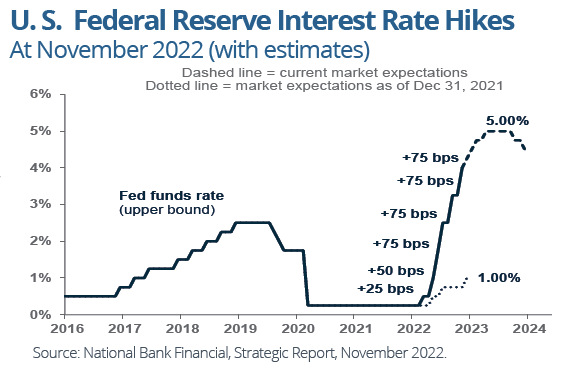
More recently, there has been a growing belief that the tightening policies may be slowing. In December, the Bank of Canada said it would be “considering whether the policy interest rate needs to rise further.”2 This may be positive news because rising rates have put downward pressure on the financial markets. For fixed income, investors will recall that bonds have an inverse relationship to interest rates: when rates rise, bond prices generally fall. For equities, higher rates mean valuations generally go down because the future value of cashflows is lower when a higher discount rate is used — this is especially true for the way in which growth stocks are valued. If a significant slowdown in inflation does become apparent in 2023, it will then allow for a return to less restrictive monetary policy.
1. www.forbes.com/advisor/investing/fed-funds-rate-history/;
2. www.bankofcanada. ca/2022/12/fad-press-release-2022-12-07/
Estate Planning , IN BRIEF
When Was the Last Time You Reviewed Your Will?
Over the years, the statistics haven’t changed much: the majority of people still do not have a Will and, for those who do, it may be outdated. When was the last time you read through your Will? Why not make your Will a priority in 2023. If you haven’t yet drafted a Will or need to make updates, in brief, here are some considerations:
Think carefully about how the Will is structured for your children. Estate lawyers suggest that many people often fail to properly plan for children. Sometimes, assets are passed in the Will to children at the age of majority without any conditions. Yet, transferring a significant amount of money at this age can lead to problems. Setting up a trust may be one way to help younger beneficiaries better manage funds. Others may neglect to appoint guardians or trustees over assets for minors. The terms and conditions for how funds are distributed to, and by guardians can also be specified in the Will to help protect beneficiaries.
Remember which assets your Will distributes (and how). Don’t forget that a Will may not include all of the assets that you hold at death. Assets held in registered accounts (TFSAs, RRSPs, RRIFs*), as well as certain pension plans or insurance policies, may have named beneficiaries which means these assets will pass outside of thee state. In most cases, joint assets will also pass outside of the estate. This is often overlooked when equalizing an estate between multiple beneficiaries. As well, don’t forget the potential effect of taxes on these accounts in reducing the final distribution of assets passing through a Will.
Pre-plan for cash flow issues. Will there be enough cash or liquidity to pay estate taxes, funeral costs or probate (in provinces where applicable)? There may be a significant tax liability for a family property or business, especially if the value has increased over time. Planning, using tools such as life insurance, can avoid future surprises.
Update as things change. Regular updates to Wills are often overlooked, such as due to changes in marital/family status, when a new beneficiary is identified, a change in jurisdiction occurs or when the status of assets changes. Administrative updates may also be needed, such as when a person named in the Will has a name change due to marriage or divorce. These updates can help to make future estate settlement easier.
Tell someone! Make sure to tell a trusted friend or loved one, as well a s the estate’s executor/liquidator, of the location of your Will.While this may sound obvious, there have been instances in which estates were settled through the provincial courts because the Will could not be located.
*Not applicable in Quebec.
Investing perspectives
Three Reminders to Start Another Year
After a difficult year, and as we look to the year ahead, here are three reminders to help keep perspective.
Volatility: Likely to persist — Periods of greater volatility tend to coincide with market drawdowns and 2022 was no exception (chart).* In 2023, we expect ongoing volatility as the central banks continue their tightening practices to rein in inflation.R ate hikes are intended to slow the economy, which may put downward pressure on earnings and lead to volatility. Downward volatility can be difficult, even for the best of us. Modern behavioural scientists suggest that we feel the pain of loss about twice as much as the pleasure of a similar sized gain. It can cause undue stress or prompt poor investing decision making. During these times, consider focusing less on the financial news or checking in on portfolios. Leave the day-to-day focus on your investments to those who are here to manage them.
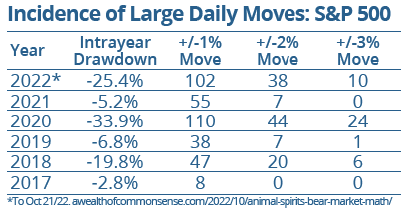
Markets will go down; This is normal — Part of investing involves accepting that the markets will go down from time to time. The good news is that, over longer periods, compounding average returns can lead to significant wealth. We often talk about average returns and it’s worth repeating that annual returns often do not fall close to this average. Consider the visual (top right) that shows the wide dispersion of annual returns of the S&P/TSX Composite Index since 1981. Annual returns are less than the long-term average of 6.7 percent (red line) in 19 out of 41 years. That’s almost one-half of the time. And, 29 percent of the time, annual returns were negative. In the short term, we can expect a wide range of outcomes, including negative performance.
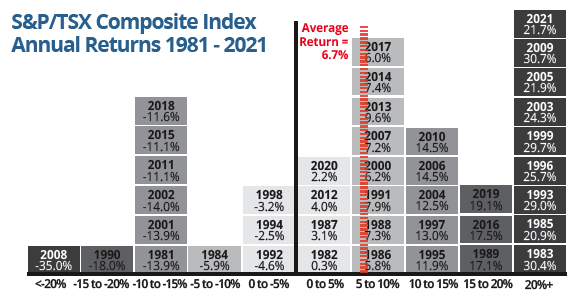
Equities continue to be one of the best asset classes to generate wealth — With increased market volatility and interest rates at levels not seen in decades, products like low-risk, guaranteed investment certificates may look appealing. While this may be a good opportunity for cash on the sidelines, if you’re investing for the long term, consider that equities continue to be one of the best asset classes in which to generate wealth and beat inflation over time, even in spite of the down years.
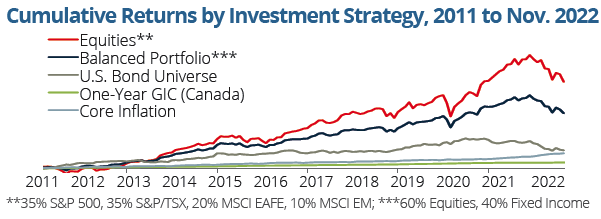
A Silver Lining to Inflation?
Adjustments to the TFSA & CPP Make a Difference
If there is any good news that can come with high inflation rates, it may be the resulting cost-of-living adjustment. Each year, certain personal income tax and benefit amounts are indexed to inflation using consumer price index (CPI) data. With inflation reaching 40-year highs in recent times, the adjustment is one of the largest in many years:

Many adjustments will take effect on January 1. For instance, the TFSA annual dollar limit will increase from $6,000 to $6,500 for the 2023 year. Other adjustments take place on July 1, such as income-tested benefits like the goods and services/harmonized sales tax credit and the child disability benefit, as this date coincides with the beginning of the program year for these benefits.
2023 TFSA Dollar Limit: As a result of adjustments for inflation, the 2023 TFSA annual dollar limit will increase to $6,500, bringing the eligible lifetime amount to $88,000. Don’t overlook the opportunity for tax-free growth!
The Impact of Inflation on CPP Benefits
Canada Pension Plan (CPP) benefits are influenced by inflation in two ways. First, they are indexed to CPI using a measure over the 12-month period ending October of the previous year. Second, CPP is also adjusted based on the year’s maximum pensionable earnings (YMPE), an amount indexed to wage inflation. Over recent times, increases to the YMPE have been significant: 4.94 percent in 2021 and 5.36 percent in 2022. This was largely due to the pandemic, when the services industry suffered and fewer people worked in lower-paying jobs, pushing up average weekly earnings.1 Increases in inflation may have a particularly significant impact on CPP benefits the longer you wait to start.
The Timing Decision Can Further Enhance CPP Benefits…
As a reminder, the standard age to start CPP is 65, but you are able to begin as early as age 60. Most people choose to start early,2 and if you start receiving CPP benefits before age 65, payments will decrease by 0.6 percent each month to a maximum of 36 percent (if you start at age 60). However, if you start after 65, payments increase by 0.7 percent each month, to a maximum of 42 percent (if you start at age 70 or after). This increased payment percentage from starting CPP later further amplifies future increases to the CPI and YMPE.
…And the Difference Can Be Significant
A recent analysis shows just how significant the impact can be by waiting.3 It looks at an individual who started CPP at age 60 in January 2020, with a decreased benefit of 36 percent (0.6% X 60 months). Assuming the maximum CPP pension amount of $1,175.83 in 2020, she received $752.53. Had she waited a year and started at age 61, she would have received $857.07 (a 28.8 percent decreased benefit from $1,203.75). If she waited until age 62, she would have received $982.81, or 30.6 percent more than if she started at age 60.
The table shows the potential increase over time, based on actual 2021 and 2022 figures. It assumes future CPI adjustments (after 2022) of 2 percent and maximum retirement pension increases of 3 percent based on existing actuarial assumptions.
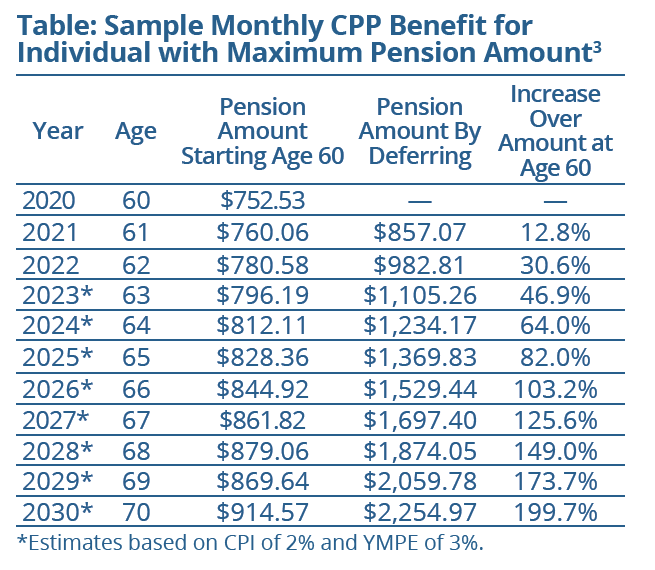
By these calculations, at age 90 an individual would have a cumulative pension that is 83 percent larger by waiting to start at age 70, compared to starting early at age 60.
Of course, many factors should be considered when deciding when to begin CPP, including expected longevity, the impact of income-tested benefits, the need for income and more. However, the impact of inflation may be one compelling reason for individuals to consider waiting to begin CPP benefits.
1. www.benefitscanada.com/pensions/governance-law/why-cpp-premiums-are-gettinga- bigger-bump-than-planned/;
2. https://financialpost.com/personal-finance/fp-answerswhen- should-i-take-cpp; 3. www.advisor.ca/columnists_/lea-koiv/consider-inflation-whendeciding- when-to-begin-cpp/

